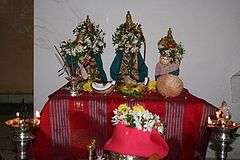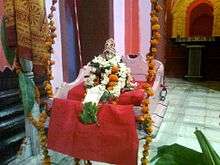Rama Navami
| Rama Navami | |
|---|---|
 | |
| Type | Hindu |
| Significance | Birthday of Rama |
| Celebrations | last day of Chaitra Navratri |
| Observances | Puja, Vrata (fast), Ramayana Katha recitation, Havan, Dāna (charity) |
| Date | Ninth day of Chaitra (Chaitra Shukla Paksha Navami) |
| 2017 date |
Wed, 5 April[1] Tues, 4 April (some states)[2] |
| 2018 date | Sun, 25 March |
| 2019 date | Sun, 14 April |
| Frequency | annual |
Rama Navami (Devanāgarī: राम नवमी; IAST: Rāma navamī) is a spring Hindu festival that celebrates the birthday of god Rama. He is particularly important to the Vaishnavism tradition of Hinduism, as the seventh avatar of Vishnu.[3][4] The festival is a part of the spring Navratri, and falls on the ninth day of the bright half (Shukla Paksha) in the Hindu calendar month of Chaitra. This typically occurs in the Gregorian months of March or April every year.[5] Rama Navami is a relatively minor festival of Hinduism and not a national holiday, but an optional restricted holiday in India.[1]
The day is marked by Rama Katha recitals, or reading of Rama stories. Ramayana and Mahabharat are considered Itihasa by Indian traditions. Some Vaishnava Hindus visit a temple, others pray within their home, and some participate in a bhajan or kirtan with music as a part of puja and aarti.[6] Some devotees mark the event by taking miniature statues of the infant Rama, washing it and clothing it, then placing it in a cradle. Charitable events and community meals are also organized. The festival is an occasion for moral reflection for many Hindus.[3][7] Some mark this day by vrata (fasting).[3][8]
The important celebrations on this day take place at Ayodhya and Sita Samahit Sthal (Uttar Pradesh), Sitamarhi (Bihar),[9] Janakpurdham (Nepal), Bhadrachalam (Telangana), Kodandarama Temple, Vontimitta (Andhra Pradesh) and Rameswaram (Tamil Nadu). Rathayatras, the chariot processions, also known as Shobha yatras of Rama, Sita, his brother Lakshmana and Hanuman, are taken out at several places.[3][10][11] In Ayodhya, many take a dip in the sacred river Sarayu and then visit the Rama temple.[12]
Significance
The festival celebrates the descent of god Vishnu as Rama avatar, through his birth to King Dasharatha and Queen Kausalya in Ayodhya.[12]
Celebrations

The day is the ninth and last day of Chaitra Navaratri (not to be confused with the autumn Navratri).[5] It celebrates the arrival of Vishnu's 7th avatar, god Rama. It is marked by the faithfuls with puja (devotional worship) such as bhajan and kirtan, by fasting and reading passages about Rama's life. Special cities in the Ramayana legends about Rama's life observe major celebrations.[5] These include Ayodhya (Uttar Pradesh), Rameshwaram (Tamil Nadu), Bhadrachalam (Telangana) and Sitamarhi (Bihar). Some locations organize Rath-yatras (chariot processions), while some celebrate it as the wedding anniversary festival (Kalyanotsavam) of Rama and Sita.[12]
While the festival is named after Rama, the festival typically includes reverence for Sita, Lakshmana and Hanumana given their importance in Rama's story.[13] Some Vaishnava Hindus observe the festival in Hindu temples, some observe it within their homes.[14] Surya, the Hindu sun god, is a part of the worship and ceremonies in some communities.[14] Some south Indian Vaishnava communities observe all nine days of Chaitra Navaratri remembering Rama, and reading the Ramayana, with some temples organizing special discussion sessions in the evening.[14] Charitable events to help those in need and community meals are organized by temples and Vaishnava organizations, and for many Hindus it is an occasion for moral reflection.[3]
In eastern Indian states such as Odisha, Jharkhand, and West Bengal, the Jagannath temples and regional Vaishnava community observe Rama Navami, and treat it as the day when preparations begin for their annual Jagannath Ratha Yatra in summer.[15][16]
Devotees associated with ISKCON fast through the daylight hours.[14] A number of ISKCON temples introduced a more prominent celebration of the occasion of the holiday with the view of addressing needs of growing native Hindu congregation. It is however always was a notable calendar event on the traditional Gaurabda calendar with a specific additional requirement of fasting by devotees.[17]
Outside India
Rama Navami is one of the Hindu festivals that is celebrated by the Indian Hindu diaspora with roots in Uttar Pradesh, Bihar, Jharkhand, and South India. The descendants of Indian indentured servants, for example, who arrived in colonial South Africa before 1910 to work in British owned plantations and mines, thereafter lived through the South African Apartheid regime, continued to celebrate Ram Navami by reciting Ramayana, and by singing bhajans of Tyagaraja and Bhadrachala Ramdas. The tradition continues in contemporary times in the Hindu temples of Durban every year.[18]
Similarly in Trinidad and Tobago, Guyana, Suriname, Jamaica, other Caribbean countries, Mauritius, Malaysia, Singapore, and many other countries Hindu descendants of colonial era indentured workers brought by the British government from India have continued to observe Ram Navami along with their other traditional festivals.[19]
It is also celebrated by Hindus in Fiji, and those Fiji Hindus who have re-migrated elsewhere.[20]
See also
References and notes
- 1 2 Holiday Calendar, High Court of Karnataka, Government of Karnataka
- ↑ West Bengal Government Holidays Calendar 2017, India
- 1 2 3 4 5 Ram Navami BBC.
- ↑ The nine-day festival of Navratri leading up to Sri Rama Navami has bhajans, kirtans and discourses in store for devotees Archived 7 April 2009 at the Wayback Machine. Indian Express, Friday , March 31, 2006.
- 1 2 3 James G. Lochtefeld (2002). The Illustrated Encyclopedia of Hinduism: N-Z. The Rosen Publishing Group. p. 562. ISBN 978-0-8239-3180-4.
- ↑ Ramnavami The Times of India, Apr 2, 2009.
- ↑ "President and PM greet people as India observes Ram Navami today". IANS. news.biharprabha.com. Retrieved 8 April 2014.
- ↑ Ramnavami Govt. of India Portal.
- ↑ Sitamarhi, Encyclopedia Britannica (2014), Quote: "A large Ramanavami fair, celebrating the birth of Lord Rama, is held in spring with considerable trade in pottery, spices, brass ware, and cotton cloth. A cattle fair held in Sitamarhi is the largest in Bihar state. The town is sacred as the birthplace of the goddess Sita (also called Janaki), the wife of Rama."
- ↑ On Ram Navami, we celebrate our love for the ideal Archived 7 April 2009 at the Wayback Machine. Indian Express, Monday , March 31, 2003.
- ↑ Shobha yatra on Ram Navami eve Indian Express, Thursday, March 25, 1999.
- 1 2 3 4 Hindus around the world celebrate Ram Navami today, DNA, 8 Apr 2014
- ↑ Steven Rosen (2006). Essential Hinduism. Greenwood Publishing Group. p. 212. ISBN 978-0-275-99006-0.
- 1 2 3 4 Constance A Jones (2011). J. Gordon Melton, ed. Religious Celebrations: An Encyclopedia of Holidays, Festivals, Solemn Observances, and Spiritual Commemorations. ABC-CLIO. pp. 739–740. ISBN 978-1-59884-206-7.
- ↑ Logs for Trinity’s chariots arrive in Odisha’s Puri town, Odisha Sun Times (January 24, 2016)
- ↑ All set for grand Ram Navami Shobhayatra, The Hitavada (15 Apr 2016)
- ↑ Zaidman, N. (2000). "The Integration of Indian Immigrants to Temples Run by North Americans". Social Compass. 47 (2): 205. doi:10.1177/003776800047002005. Retrieved 2008-06-01.
Another example of a religious enterprise initiated by a board member was the organization of Lord Ramachandra Appearance Day (Sri Ram Navami).
- ↑ Paula Richman (2008), Ways of Celebrating Ram's Birth: Ramayana Week in Durban, South Africa, Religions Of South Asia, Volume 2 Issue 2, pages 109–133
- ↑ Steven Vertovec (1992). Hindu Trinidad: Religion, Ethnicity and Socio-Economic Change. Macmillan Academic. p. 211. ISBN 978-0-333-53505-9.
- ↑ Brian A. Hatcher (2015). Hinduism in the Modern World. Routledge. pp. 116–117. ISBN 978-1-135-04631-6.
External links
| Wikimedia Commons has media related to Ramanavami. |

.jpg)
